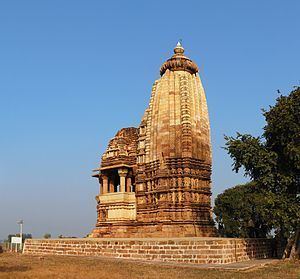 | ||
In Hindu temple architecture, a ratha is a facet or vertical offset projection on the tower (generally a shikhara).
Contents
- Examples of triratha temples
- Examples of pancharatha temples
- Examples of saptaratha temples
- Examples of navaratha temples
- References
In Sanskrit, the word "ratha" means "chariot", but the link with this meaning is not clear.
The rathas are decorated with geometric figures or statues, such as statues of a gatekeeper watching outside or a niche with a statue of a deity.
Sometimes, the facet of the ratha is hollowed to the interior; these are rathas with recesses.
If there is only one facet, this is a temple with three rathas (triratha): the wall and the facet on the left and on the right.
If there are a main facet and a secondary one, the temple has five rathas (pancharatha). There are also temples with seven rathas (saptaratha). and nine rathas (navaratha).
Examples of triratha temples
Examples of pancharatha temples
Examples of saptaratha temples
Examples of navaratha temples
References
Ratha (architecture) Wikipedia(Text) CC BY-SA
